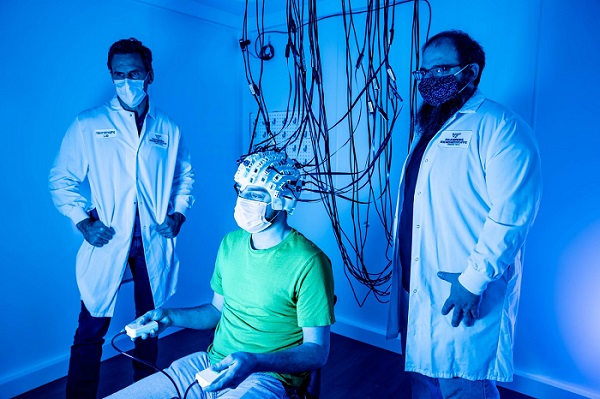Researchers at the Fralin Biomedical Research Institute at Virginia Tech Carilion School of Medicine (VTCSM) received a $2.4 million National Institutes of Health grant to use optically pumped magnetometry to explore neural activity during face-to-face human interactions. The researchers will optically measure the brain’s magnetic signals in two research volunteers simultaneously as the volunteers interact, capturing the nuances of the brain’s signaling in real time.
Brain cells generate electrical currents that emit tiny magnetic fields. Optically pumped magnetometers use quantum sensor chips to measure the strength and originating location of these fields, and they are sensitive enough to detect magnetic fields on the quantum scale of femtoteslas, about a billion times smaller than Earth’s magnetic field.

Professor Read Montague (left) and professor Stephen LaConte (right) work with research assistant Chris Huck to demonstrate the new optically pumped magnetometry technology. Montague and LaConte received a $2.4 million National Institutes of Health grant to explore the neural underpinnings of face-to-face interactions. Courtesy of Clayton Metz/Virginia Tech.
Optically pumped magnetometers work by passing a laser beam through a glass cell filled with vapor. The magnetic fields generated by the brain shift the vapor’s atomic energy levels in the cell, either enhancing or fading the light current. The cell’s sensor detects changes in the laser beam and produces an electric current proportional to the amount of light passing through it, converting a magnetic signal into an electric one.
The researchers use computational modeling to visualize which brain regions are most active during certain tasks, such as tapping a finger or playing a game with another participant.
Unlike MRIs, which require a person to lie down and stay still, the optically pumped magnetometry devices are wearable, lightweight headsets that allow research volunteers to move around, interact with others, and sit upright while brain activity is being measured.
Professor Read Montague, who is the principal investigator, and his team at the Fralin Biomedical Research Institute have established one of the first optically pumped magnetometry laboratories in the U.S. The lab is located inside a magnetically shielded room made of mu-metal, a nickel-iron alloy, to protect it from outside magnetic signals that could interfere with the data.

In 2010, NIST researchers published the first study describing the use of miniaturized atomic magnetometers to measure biological activity in the brain and heart, which spurred Montague’s interest in the subject. This technology was refined by QuSpin, a company led by Vishal Shah, who is a consultant for the NIH grant. Researchers at the University of Nottingham, currently collaborating with Montague’s team, were among the first to evaluate the technology.
The VTCSM researchers, in collaboration with the Nottingham team, will be the first to use optically pumped magnetometry to conduct movement-tolerant brain imaging simultaneously with two research volunteers.
“It is difficult to overstate the importance of face-to-face interactions for human neuroscience. Face perception is one of the most critical functions in social interactions and is one of the most vital human perceptual skills,” professor and co-principal investigator Stephen LaConte said.
The optically pumped magnetometer could lead to new ways to study people while they’re awake and in motion, as well as research volunteers who have movement disorders.
“We’re giddy to get people outside of magnets and into a setting where we can study social interactions, humans of all ages and sizes, and people in motion with fewer environmental limitations,” Montague said. “We’ve never had the ability to make such sensitive direct magnetic measurements, and now we’re applying this transformative technology in the social domain.”
The researchers expect the Human Magnetometry Laboratory to become a shared resource for neuroscientists at the Fralin Biomedical Research Institute. “Our investment in human magnetometry positions Virginia Tech to unlock previously unrealized potential for gaining new insights into healthy brain function and a range of brain disorders that impact children and adults,” Michael Friedlander, executive director of the institute, said.
Researchers at the Fralin Biomedical Research Institute are studying ways to measure the brain’s magnetic signals in two research volunteers simultaneously as they interact, capturing the complexity of the brain’s signaling during face-to-face situations in real time. The device uses quantum sensor chips to measure the strength and originating location of magnetic fields produced by the human brain. Courtesy of Clayton Metz/Virginia Tech.